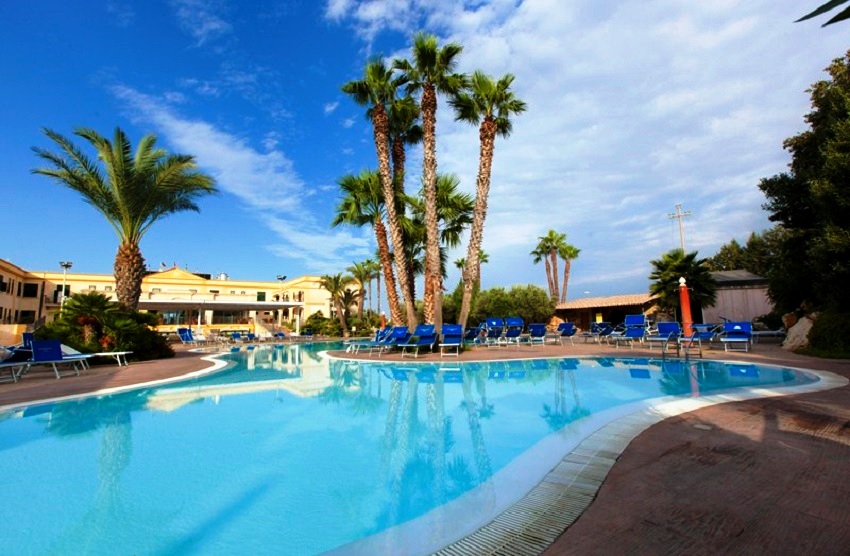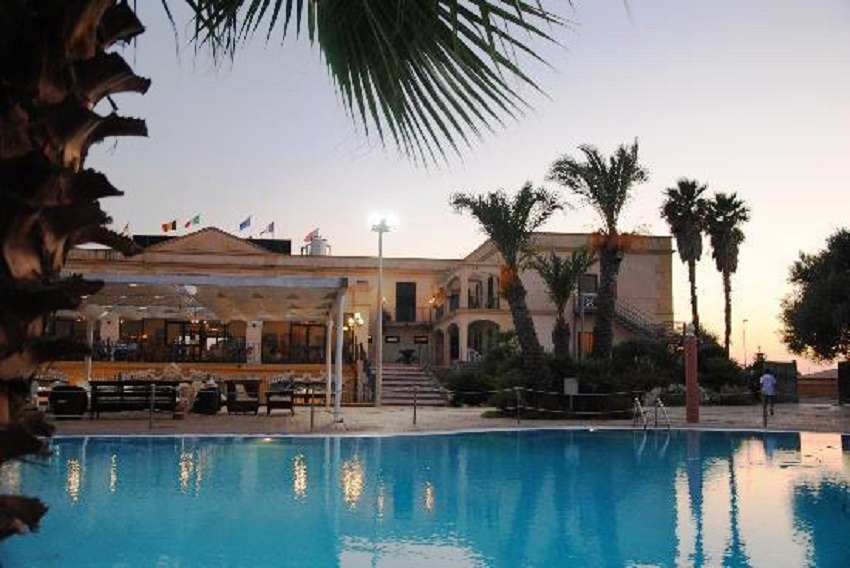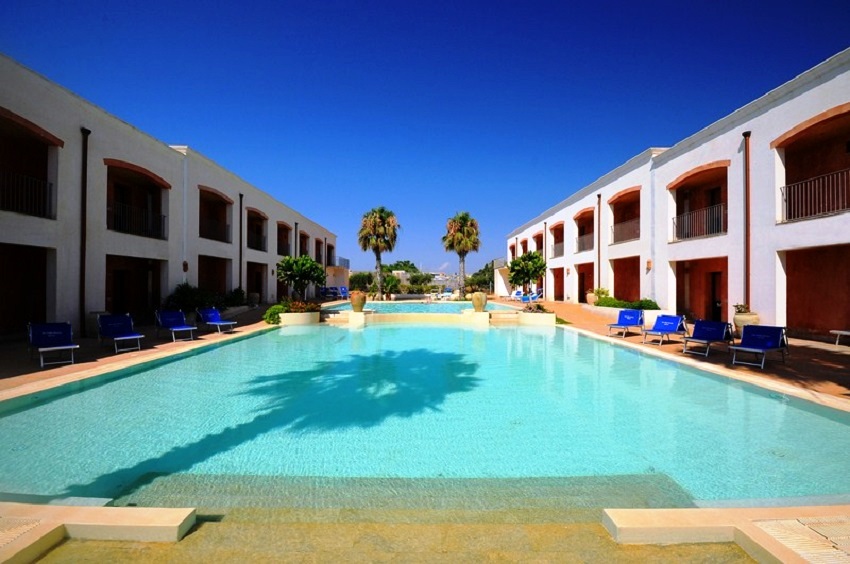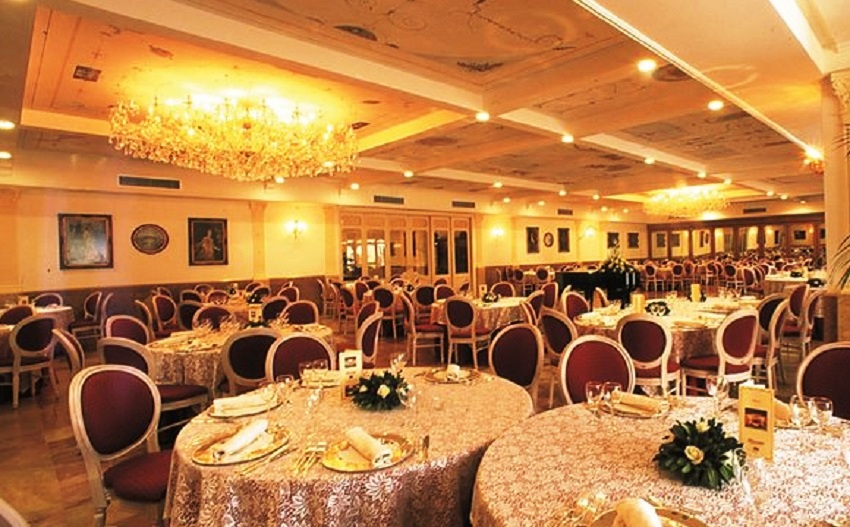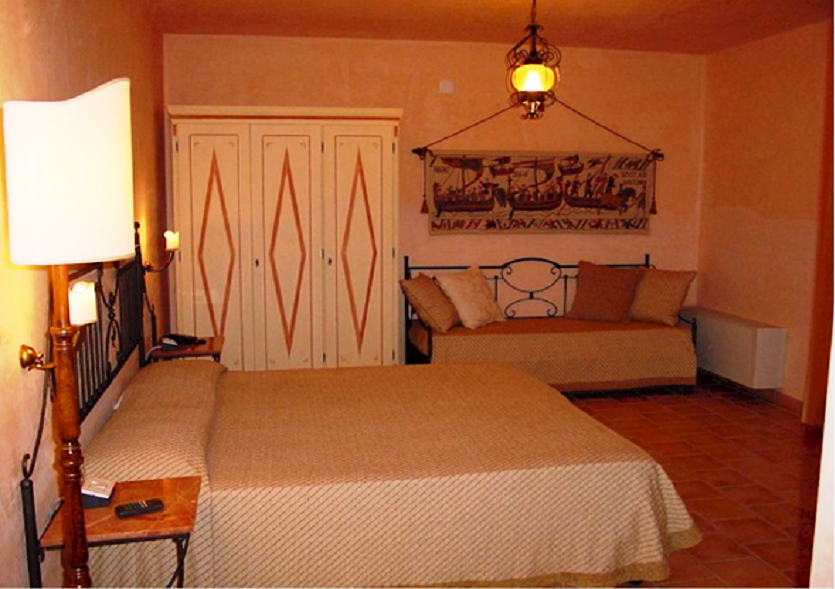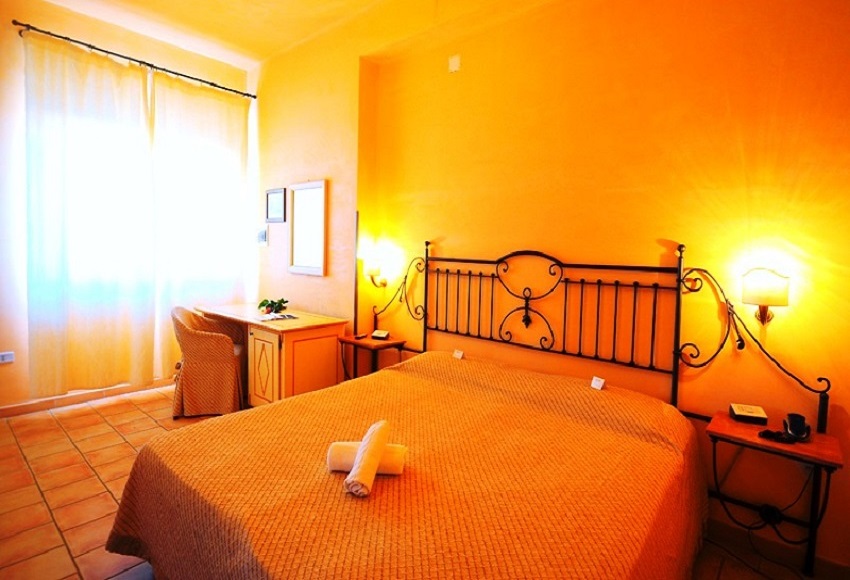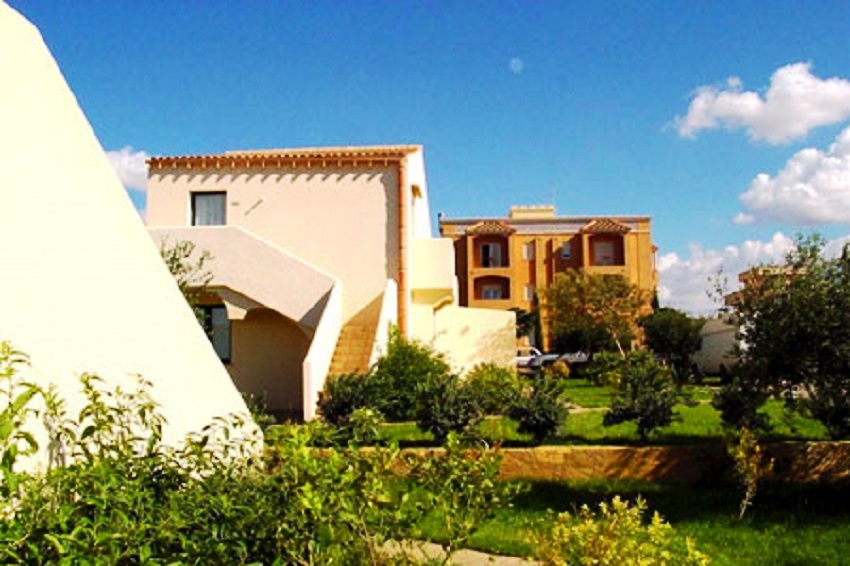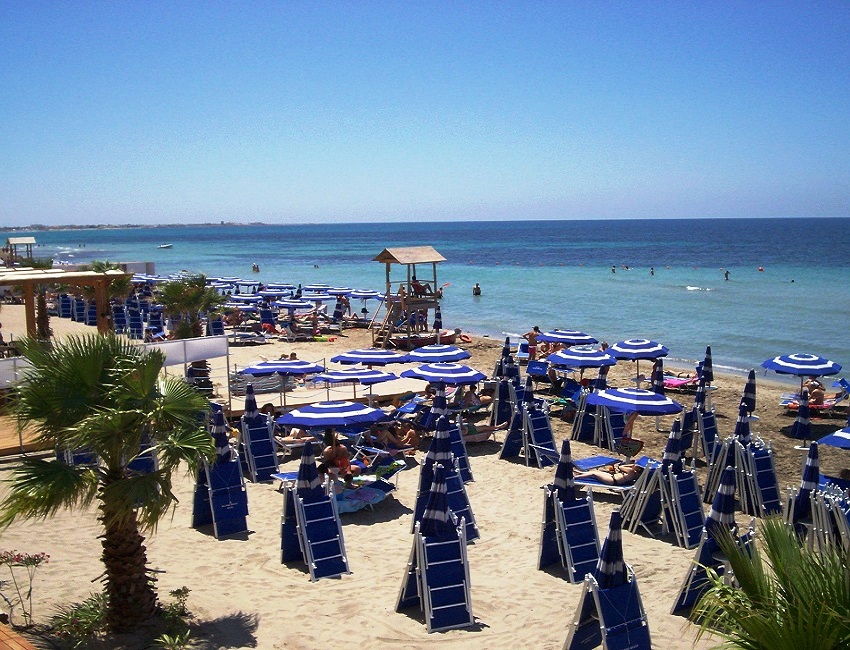General
Resort consisting of a main body structure prestigious composed of the Hotel and Residence, consists of four blocks on two levels with Mothia apartments, surrounded by a flower garden and rare species of palm .
Location: situated close to a long and sandy shore, a few steps from the sea with pedestrian crossing and four kilometers from the center of Marsala.
|
Description: surrounded by a flower garden and rare species of palm trees consists of a main three-storey Lillibeo body, with services and rooms, a body-detached three-storey Marsallah rooms 200 meters away, two bodies and four Garibaldine blocks two-storey apartments with Mothia.
Rooms: 98 between Lillibeo decorated in Art Nouveau style with prestigious finishing touches and furnishings, Marsallah expertly finished with possibility of mini suites, ideal for families. Garibaldi with separate entrance away, on two levels, some with kitchenettes. Marsallah rooms for disabled.
Facilities: bathroom with shower or tub and hairdryer, telephone, internet connection, satellite TV, minibar, safe and air conditioning. Whirlpool in a few rooms.
Mothia apartments: 16 single apartments with independent entrance furnished in Mediterranean style. Also in Formula Apparthotel. Facilities: bathroom with hairdryer, telephone, TV, safe and air conditioning. Garden equipped with deck chairs and umbrella. Mono 2/4: living room with hideaway kitchenette, double bed, sofa bed.
Food service: breakfast buffet, two restaurants with local and international cuisine, including one on the beach, open only for lunch with table service or buffet; dinner with buffet service and bottled mineral water and house wine with meals from 31/05 to 12/09. Snack bar with restaurant service on the beach open from mid-June to mid-September .
Services: lobby bar in the main building, elevator, lounge, Wi-fi zone, meeting rooms, newspaper delivery, pool, gym, table tennis, children’s playground. unguarded parking. Small pets allowed with vaccination. Credit cards accepted. Additional services with surcharge: drinks, baby sitting, extra drinks, wi-fi zone in addition to the 20 minutes, car rental.
Beach: sandy and platform for disabled, accessible by pedestrian crossing. Beach service (not included in the Club Card): € 10.00 per room per day, payable on location, to be requested when booking. Includes: one umbrella + 2 beds per room; the umbrella position is random and can not be booked.
Club Card: mandatory from 24/05 to 20/09 children 4/12 years € 10, adults € 30 per person per week (for stays less than a week Club card free for children € 5 per day for adults) direct payment, includes: welcome drink, entertainment with day and evening entertainment, Mini Club 4/12 years every day at the beach and swimming pool, sports activities, pool chairs until finished, ping pong, tennis, soccer indoor. twice a week bus to/from Marsala center.
![]() Rates in Residence in low season from € 350, to Mothia studios, 2 seats.
Rates in Residence in low season from € 350, to Mothia studios, 2 seats.
Prices in Hotels in low season, from € 52 per person, with half board, in a standard room.
Prices do not include: membership: € 30 adults, € 15 children up to 12 years. beach service (to be requested when booking: 1 umbrella + 2 sun beds € 10,00 per room per day
Important to Know:Weekly stays from Saturday to Saturday or Sunday to Sunday. Arrival 2 p.m. departure 10 a.m.
Additional services: possibility to combine flights or travel in forward ritrono ship and the place of origin and transfers to and from Palermo and Trapani Airport.
Trapani
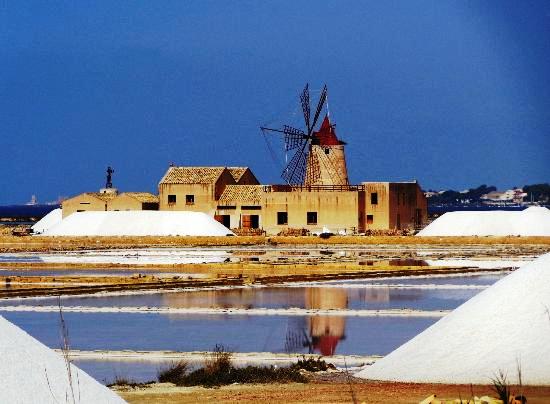
Trapani Located in the extreme western part of Sicily it offers the visitor a varied territory and always different for landscapes and colors that make it up. The blue of the sea lapping the coastline alternating beaches with cliffs, the white of Saline, the green vineyards and olive groves, the inland countryside and protected areas, the ocher yellow of the Greek temples and monuments, the red sunsets. Along the shore adjacent to the city and then gradually along the coast, up to Marsala, heaps of salt are white along the shore, guarded by windmills, with their big blades, stand out against the sea like fantastic monsters. small town in its sea cradle Trapani hide their treasures to show them only to those who can appreciate them. On its shores they are alternated many more or less fantastic populations beginning with the Cyclops, the helmets, the Trojans, the Phoenicians. Subsequently, the center becomes even more important with the Carthaginians that make it one of the most important city in western Sicily. The Normans concentrated in it the industrial activities of coral and gold and giving it the character of seafaring town devoted to fishing and trade. Among the monuments that stand out for their beauty there is the 1635 Cathedral of S. Lorenzo, with a special baroque facade and a three nave interior rich in precious paintings; the church of S. Maria del Gesù, built in the sixteenth century, with a facade built in Gothic-Renaissance style and a more gothic side, with an Annunciation by Catalan Gothic School. In the district of the old ghetto you are located on the Giudecca Palazzo, also called “the Spedaletto”, typical Catalan architecture with blocks cut with a diamond tip that cover a large part of the facade. To do in Trapani is the sanctuary of the Annunciation which has a facade of four very well preserved with a central rosette.
Erice It stands on top of a lonely mountain, which dominates Trapani, the valley and the mare.Uno the firmest eyes of the Mediterranean. It is not easy to explain through comparisons the emotional intensity that the sunset, seen from the summit, knows to donate. Changing colors are reflected on the sea, the sunset behind the Egadi islands, the glare of the salt crystals of the ancient salt, the legendary sickle shape of the city of Trapani, everything seems to sparkle dusk. In particularly clear days, the horizon line gives us the extraordinary view to the west of the African coast and north-east over Mount Hood, of ?? island of Ustica surprisingly close. But the view knows lost the western hinterland of the island, through the plains of Trapani and Marsala and Val di Mazara, all to the hills of Agrigento. Among all the Sicilian resorts, Erice is the most fascinating for its enchanting places and for its various fascinating traditions. It lies at the summit of Mount San Giuliano dominating Trapani by a fabulous view. Its origins are ancient and mysterious, shrouded in legend. On the summit it was built first only a temple, dedicated to a female deity from the fertile nature. It was always venerated by all Mediterranean peoples and her main concern was to protect sailors who far away noticed the fire that burned in the sacred building and that served also from guideline. Soon there was a dispute fortress built by Phoenicians, Greeks and Carthaginians. In Roman times Erice is particularly important because its sanctuary was put in charge of a religious confederation of 17 cities and the time of Tiberius and Claudius the temple was restored. With the Arab conquest the fortress takes on new importance and even more so with the Normans. In 1934 the city summarizes the ancient name of Erice. It is enjoying exceptional insulation position that has enabled it to preserve its medieval aspect with its cobbled stone streets, steep hills, the picturesque houses, flower-filled courtyards to the Arab way and the incomparable beauty of the landscape. The most important monument in Erice is the fourteenth-century Church of the 1314 Matrix flanked by an imposing bell tower with graceful mullioned windows and battlements. The charm of its ancient history and its beautiful landscape, Erice adds the advantages of its healthy climate and pleasant: the pine forests create a fresh atmosphere that makes the town a tourist health resort. Erice is a place rich in features shops: finely decorated ceramics and hand-woven rugs. It also has the possibility to taste typical gastronomy Dolci di Badia, made with almonds and candied fruit paste The “Genoese”.
Sports and nature
The Natural Reserve of the Gypsy who wants to immerse themselves in a timeless nature, where past and present merge, must visit this reserve. Between Scopello and San Vito lo Capo stretches about seven kilometers and is the first nature reserve established by the region, the coastline is characterized by high cliffs interspersed with white coves washed turquoise sea, within walking distance from the main path. To advance allow other paths of the oasis and stroll through dwarf palms, large carob trees and other Mediterranean vegetation specimens. The reserve is visited only by foot, nothing should disturb the forty species of birds that nest here (including Bonelli's eagle, the buzzard, the kite, the kestrel) and endemic fauna. Many plants that grow here are rare and characteristics of the area; trees living on the slopes of the mountains that fall in the reserve are carob trees, olive trees, ash trees, some cork stem; the most common plants euphorbia and lentrisco. Zingaro is famous for its sea of intense blue, its silent coves and protected by the rocks where the hawk circling in search of prey, for his clear and waters rich in fish and underwater caves. But it's not just this. The reserve fall several peaks that reach a maximum height of about a thousand meters, and if near the coast were the testimonies of eight thousand years ago life - the dell'Uzzo cave - inside are still visible remains of a civilization much more recent peasant, who deserves to be remembered. In the Zingaro were some olive groves of almond, of Frassineti and also a piece of land devoted to arable land, which is located around the Borgo Cosenza, about seven hundred meters above the sea; a portion of these crops is still active, another part is private and is cultivated by the owners. In both cases, however, the traditional methods of cultivation and harvesting are applied. The restoration project of the "Baglio Cosenza" (completely abandoned in the early 50s) is within the programs of the Reserve: store on site the testimonies of the material culture, and restore dignity and life to the social and economic reality. The reserve is fully enjoyed by all; three are the classic tracks: the first runs along the coast from one of the reserve limit (is the most popular, and also the least challenging), the second proceeds in a zig zag on the territory, crossing the coast and the peaks (more challenging), the third is reserved for the sport as it crosses the entire Gypsy top to bottom. There are hiking trails and places to rest, old restored farmhouses where "camp out", you can also stay in these buildings. The only imperative is: no littering, do not pollute, respect the sea, earth and sky. The reserve concerns only the "land" of Zingaro, while on the sea the only prohibition is to get close with the boat engine running at more than 300 meters from the coast. The depths of San Vito Lo Capo lend themselves very well to scuba diving: tall fringed the many shoals that are located a few hundred meters from the coast offer beautiful scenery, suitable for underwater photography. In some areas just exceed 40 meters to find the first branches of red coral, small and of no commercial value, but coveted by photographers. For those spearfishing, dry Lighthouse (depths from 4 to 30 meters) is able to give great emotions (white bream and croaker common prey). In 1300 coral of Trapani, San Vito lo Capo and Bonagia, he was known throughout the Mediterranean, and considered the best quality. On the rocks of Cala Mancina and the "Cutting Sword" (an underwater cliff at a mile and a half from the shore) the wonderful corallium rubrium, the red gold of the sea, still lives, and you can buy some nice branch ended up randomly from the fishermen's nets. All the seabed around Capo San Vito is rich in evidence of ancient maritime trade: different age amphorae and especially anchors in lead (IV century BC - fifth century AD) that the time of abandoned ships on the bottom for the arrival of the enemy fleet , for a sudden storm, or more simply because stuck between the bottom rocks. The richness of the finds is proof of the importance Cape Egitarso in the Mediterranean sea routes than two thousand years ago. An Arab Norman wreck (dated around the year 800) sank at a depth of about 25 meters in front of the Cape San Vito, studied, photographed and recovered from 1993 to 1995 on behalf of the Superintendence of Cultural Heritage.Read more

